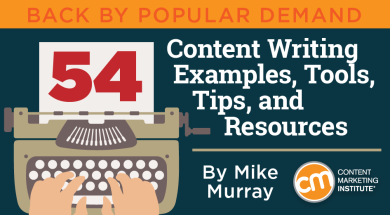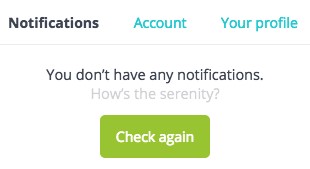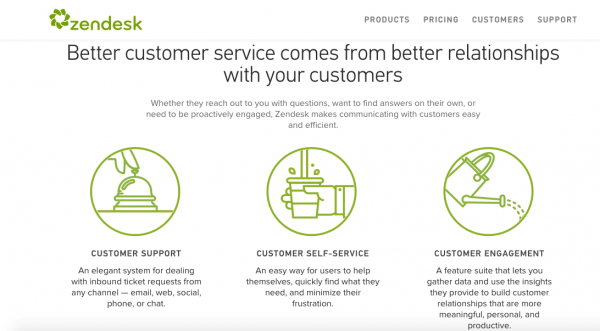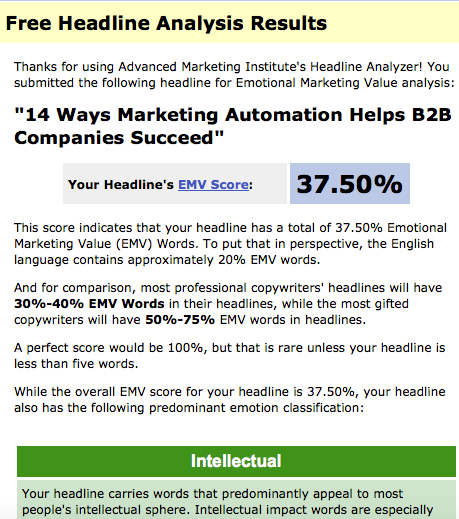54 Content Writing Examples, Tools, Tips, and Resources
54 Content Writing Examples, Tools, Tips, and Resources
 Editor’s note: You may have missed this article when CMI published it in 2016. We’re publishing this update because great writing is so essential to successful content marketing.
Editor’s note: You may have missed this article when CMI published it in 2016. We’re publishing this update because great writing is so essential to successful content marketing.
Consuming great writing is like listening to a great singer. If the performer makes an emotional connection with me – even though she misses a few notes – I eagerly listen to the rest of the song and anticipate the next performance.
A year ago, I shared helpful lessons on powerful and effective text with 48 examples, tools, tips, and resources. Today, I share those plus another six to help you win over as many of your readers as possible.
Lesson 1: Power up video text
U.K.-based web designer Purplefeather created the powerful Change Your Words, Change Your World video. In it, a four-word plea (I’m blind. Please help.) is changed into a nine-word sentence (It’s a beautiful day and I can’t see it). The text transformation generates far more compassion.
Since its 2010 debut, the video has been viewed over 24.7 million times and received thousands of comments on YouTube.
Lesson 2: Create something that must be read
In 2013, the National Agency for the Fight Against Illiteracy in France earned accolades for its print ad campaign. Viewers had to read the ads to discover what they were really about – not only creating awareness of the fight but also demonstrating the actual value of literacy.

Source: BuzzFeed
Lesson 3: Get to the point
Visual content is a useful vehicle for your messaging. Market Domination Media took a meta approach to explaining why infographics work by creating an infographic. Note that the text is minimal and gets straight to the point, stressing facts over long descriptions.
Infographic by: Market Domination Media
Lesson 4: Don’t be so serious
Design program Canva uses lighthearted content touches to connect with its readers, such as this simple way to mention notifications.

Lesson 5: Think smart
Headline writing involves many challenges – tone, length, etc. This headline from Business Insider appears to be straightforward – good use of a numeral, direct, etc. But the word “smarter” caught my attention and elevated the post’s value in my mind.

Lesson 6: Use text to help visualization
The Dropbox blog provides numerous examples of how to use the service. I like the crisp writing that consistently includes realistic examples based on diverse needs.

Lesson 7: Explain succinctly
Zendesk elevates its customer service by writing briefly to illuminate the difference among customer support, customer self-service, and customer engagement. With a few words, Zendesk communicates to its customers that it cares about their relationship and wants them to access the best resource to help them right away.

Tip 1: Know your audience
You need to speak their language, but it doesn’t mean settling for jargon that can clash with creative phrasing. Typically, an informal, conversational approach works best when you’re creating content.
An informational, conversational approach works best when you’re creating #content via @mikeonlinecoachCLICK TO TWEETOther content writing suggestions include:
- Focus on actionable content that someone can use in their lives or jobs right away.
- Write in first-person or second-person.
- Be careful with humor, which can fall flat for the reader.
- Use profanity rarely because it can throw off someone who may wonder why the content includes those words.
- Don’t be so creative that a reader struggles to detect your main point.
- Avoid starting sentences with vague words like “this” or “that.”
- Link to other websites, newsletters, and blogs because the links provide added value to visitors and help establish your credibility.
- Identify potential keywords that you should consider by using Google’s Keyword Planner and Soovle, which provide examples of what keyword phrases people use when they search.
Tip 2: Get visitors to take the right actions
Sometimes it’s a simple word or phrase that can prompt someone to take the next step. Buffer offers a list of 189 words, including words that focus on exclusivity.

Tip 3: Remember that length depends on the context
It’s easy to stick to some content length rules and preferences.
For example, you will want to maximize the 35 characters you get on each line of a Google ad. With social media, you might improve engagement by stopping well short of the maximum character limits.
It gets tougher with website pages, articles, and blog posts. I understand that short pieces (let’s say anything under 500 words) are easier to consume for online readers. But longer content can draw in people as well. Visuals in the core content and within the site architecture can support your text.
Odds are that your agency or company will have policies that control length. But there should always be exceptions.
If you don’t write enough, you disappoint someone by not devoting sufficient attention to a topic. If you provide too many details, you might overwhelm a reader who might miss your primary ideas.
Editors and writers should agree on whether the article is a suitable length. You can discard information that doesn’t quite fit. But in the content writing and editing process, you might identify opportunities to use some portions for future content (with additions or modifications).
From a search engine optimization perspective, longer content is always best. A website, for example, can get by with shorter pieces if it becomes authoritative through its age, the number of pages, inbound links, and more. However, extended content often helps generate high rankings for targeted keyword phrases and similar words.
From a #SEO perspective, longer #content is always best says @mikeonlinecoachCLICK TO TWEETTip 4: Ensure that your content can be scanned (especially with websites)
Readers will skip many of your words. Make it easy for them to discover your key points by including:
- Short paragraphs
- Subheads
- Bulleted lists
- Bolded text
- Words in color
- Links
You don’t need to write long sentences to get your point across. Short ones will work in your favor. It’s the same thing with words. Here are some examples (sometimes a few short words sound better than one long word).
- Indicate show
- Eliminate get rid of
- Utilize use
- In order to to
- Facilitate help
- Obtain get
Tip 5: Understand fair use
As a content writer, you may occasionally use other content. It’s not always enough to simply use quotation marks and cite the source.
Fair use depends on several factors, including whether your content is used for commercial purposes and its potential impact on the market value of the copyrighted work.
I mostly worry about the length of the original source. If I quoted 100 words from a 250-word blog, I think that would be too much. A lawyer would have the best advice, but I would limit the quote to 25 words in that case. Books are a little easier. If you quote 300 words from a 150-page book, I believe you would be fine. Poems and song lyrics are a danger zone because they’re often short. I’ve cited as little as possible from them. It’s always best to get legal counsel before publishing the final content.
Tip 6: Evaluate sentence structure with the Hemingway App
Content writers have many tools to reference to make their jobs a little easier and to improve their work. Among the best is the Hemingway App, which provides immediate feedback on content structure, including sentence formatting. With the website version, replace the default text with your own.

Tip 7: Create compelling content with the right words
Jon Morrow of Smart Blogger, previously Boost Blog Traffic, offers an extensive collection of words that can make a difference in what you write: 317 Power Words That’ll Instantly Make You a Better Writer.

Tip 8: Use a blog topic tool if you need inspiration
HubSpot’s Blog Topic Generator works well to get your creative content writing juices flowing. All you have to do is fill in the fields with three nouns to get blog topic ideas.

Tip 9: Evaluate the complexity of your sentences
The Readability Test Tool scores your content, including the grade level and the complexity of words.
Tip 10: Analyze the impact that your headlines could have on readers
Size up headlines with the Emotional Marketing Value Headline Analyzer.

A similar tool, the CoSchedule Blog Post Headline Analyzer, looks at tone, grammar, structure, and more.
Writing is a dream job, but not for everyone. Some writers are hired to write product descriptions for catalogs, and some turn out to be J.K. Rowling. Unfortunately, however, most writers have a better chance of writing product descriptions than they do of becoming best-selling authors.
Related: How to Create Great Content for Your Website
While successful content writers seem to have an enviable life -- they work from home, make their own schedules and work as much or as little as they please -- the vast majority have a hard time making a living of it. They lack the skills necessary to succeed. Because no matter how talented they are, writing skill is simply not enough. So, if you want to become successful as a content writer, you need a full toolkit of marketable skills.
1. Successful content writers must master different writing styles.
The reason is that each form of writing has its own style. News is delivered AP style, in short, informational paragraphs with the meat of the story at the top. Blogging is personable, friendly and often opinionated. Ad copy is short and persuasive. White papers are long; they describe a problem and provide the solution. But, regardless, each and every category is content, and each style writers master makes them more valuable and in demand.
2. Successful content writers don't pick random subjects.
"Ideation" is a marketing industry buzzword that describes the creative process of finding a subject, title and angle to write about; and ideation begins with analytics. Most ideation is done in a team setting, but freelance writers are usually on their own. Which is why it's helpful to know how professional marketing teams generate ideas. Before doing that, successful content writers need to:
- Understand their audience. Marketers call it creating a "buyer persona." If you know who your readers are, you can write what they want to read. You write for your audience. Not for yourself, not for your company, not for your brand.
- Perform keyword research. Buzzsumo.com showed that “content writing” is a better keyword than “content writer,” which is what led to a title change. The site also revealed that writing how-to posts are popular. One by Neil Patel on how to come up with topic ideas was shared nearly 16,000 times. (swoon)
- Check out the competition. What successful content are others in your industry sharing? A competitive content audit gives you a ton of information. Not just about what your competitors are sharing, but who is linking to their content, blogging about it, tweeting it out and posting it elsewhere.
- Craft a snappy title. After you have keyword, competitor and reader knowledge, take your time, choose your subject and craft a title that will interest readers. The title compels people to read. . . or not. The most important words on your post are the title and the meta description.
3. Successful content writers are original.
It's your reputation. Every post with your name on it should be original. That probably sounds crazy, with all the tens of thousands of people writing about the same subjects, but it's easier than it seems. Every talented writer can bring a unique voice, different perspective or new light to an overworked subject.
Related: 6 Ways to Get the Most Out of Your Content
Plagiarized content is bad for SEO, bad for your employers and even worse for you. Protect your reputation and your career by taking precautions. Before you submit your work, use an online program to check for plagiarism. With all the content out there, it's easy to accidentally duplicate writing.
4. Successful content writers know SEO, HTML, CSS and WordPress.
Don't panic. You only need a few basics. WordPress themes have varying levels of automatic functions, and sometimes the only way to make your text appear the way you want it to is to dig into the text/HTML tab and manipulate the code to make a title tag or fix a spacing issue. It's worth your time to learn the basics.
Updated SEO knowledge is also critical. Search engine algorithms change constantly, and writers have to keep up. One thing remains constant: High quality is always in demand. If you can write in-depth content from a unique perspective, you'll be in demand.
5. Successful content writers are social media specialists.
Name recognition is important. Social media puts everything you need within your grasp. Build your audience, meet publishers and talk to industry experts. When your writing is published, the fun has only just begun. The more active you are on social media, the more likely your followers will be to recommend your content. Successful content writers are active, public and friendly.
So, think again about writing "success." It stops being about words on paper as soon as “content” is added to “writer.” Content writers are marketing experts, SEO specialists, on-page coders and social media butterflies. With the right skill set, you'll succeed and find that yours is the best job in the world.
After reading everywhere that content marketing is the best way to promote your business on the Internet, you’ve decided to try your hand at writing some content. Even if you are an accomplished writer in other mediums, you will find that content writing guidelines are a bit different because you are writing for Google as well as for your audience. It can be a bit daunting when you are new to content writing, so we have some content writing tips for beginners to help you get started.
Write a compelling headline
The headline of your content serves a triple purpose. It needs to grab the attention of readers, provide an accurate summation of the information, and meet search guidelines to help Google assign as high search rank.
Headlines should include your focus keyword, ideally be between 55 to 70 characters, and contain a 6 to 7 word count. Headlines that are in the form of a list, a “How to” guide, or question tend to rank the highest. CoSchedule’s free headline analysis tool will help you get the hang of formatting headlines for the highest search ranking.
Make your content easy to read
Your content needs to be formatted so it is easy for readers and Google to scan and understand. Long pages of text can be difficult to read online, especially on small smartphone screens. Online readers tend to scan through content to find points that they are interested in, rather than plowing through a long article.
Instead of paragraphs of three to four sentences, break your writing into short paragraphs of one or two sentences so it is easier to read. Use bolded sub-headings to separate your content into topics or ideas, so readers can easily find the concepts that interest them.
Numbered lists and stories with bullet points are popular formats because they are easy to read. Organizing your content this way also helps Google to index it so it gains a higher search position.
Focus on the topic, not keyword stuffing
The basic rules of content writing are similar to the writing guidelines you learned in school, with just a few important changes. You need to include keywords, but you should concentrate on producing well-written, high quality content that clearly explains the topic.
Keyword stuffing will actually get your content penalized. Instead, just include a focus keyword three to four times and use secondary keywords twice at the most.
Word count matters
There is a general rule that longer content is rewarded with a higher search rank. In order to get the highest search ranking, content should be 1000 words at a minimum, and is typically between 1500 and 2500.
A recent search engine study found that top ranking content averaged 1890 words. Don’t worry about producing such long content to start, though. Content that is at least 500 words in length is long enough for Google to index and assign a positive search rank.
Proof your content
Proofing your content may seem like an unnecessary addition to these content writing tips for beginners, yet the internet is full of blogs and other content that is riddled with grammar and spelling mistakes. Your content represents your business online and may be a customer’s first contact with your brand – so poorly proofed content can actually damage your company’s image.
Using a word processing program to check spelling and grammar mistakes is helpful, but can leave you with homonym errors. For the best results, have another person check your writing for mistakes. If that is not possible, Grammarly is a free tool that does a good job of finding common errors.
Practice, practice, practice!
Content writing is like any other skill – the more you do it, the easier it becomes. You can find free tools online that will analyze your content and give you tips on how to improve content writing skills. One of our favorites is the Hemmingway app, which gives you pointers on corrections that will make your writing short, clear, and easy to understand.
If you find you would rather focus on managing your business, you can trust Blue Interactive Agency to handle your content writing chores for you. As a full service interactive marketing agency, we can provide you with high volume content writing services, analytics, distribution services, and more, delivering everything you need for a winning content marketing strategy.

Comments
Post a Comment